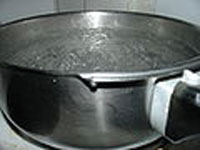2.1.2 Epidemiologic classification
This classification is based on the main mode of transmission of the infectious agent. The importance of this classification for you is that it enables you to select prevention and control measures which are common to (shared by) communicable diseases in the same class, so as to interrupt the mode of transmission. To clarify the importance of epidemiologic classification, consider the following examples.

Cholera and typhoid fever are two different diseases which can be transmitted by drinking contaminated water. Therefore, they are classified as waterborne diseases, using the epidemiologic classification. The common prevention measures for the two diseases, despite having different infectious agents, include protecting water sources from contamination and treatment of unsafe water before drinking, for example by boiling (Figure 2.2) or adding chlorine.
The main types of epidemiologic classification are described in Box 2.2.
Box 2.2 Epidemiologic classification of communicable diseases
Based on the mode of transmission of the infectious agent, communicable diseases can be classified as:
- Waterborne diseases: transmitted by ingestion of contaminated water.
- Foodborne diseases: transmitted by the ingestion of contaminated food.
- Airborne diseases: transmitted through the air.
- Vector-borne diseases: transmitted by vectors, such as mosquitoes and flies.
Suppose while you are working in your health facility, a 20 year-old man comes to you complaining of high fever accompanied by violent shivering (rigors), vomiting and headache. A blood examination for malaria found evidence of Plasmodium falciparum. Assume that he acquired the parasite after being bitten by infected mosquitoes. How would you classify this man’s health problem, using two different classifications?
You will learn how to carry out the rapid blood test for malaria in Study Session 7 of this Module.
Clinically the disease is classed as a febrile illness because fever was the main clinical manifestation. Using epidemiologic classification, the disease is classed as vector-borne because it was transmitted by the mosquito.
When you have studied more about malaria in later study sessions, you will be able to see how the clinical classification as a febrile illness can help you in the management of the patient. As he has a high fever, in addition to treatment with anti-malarial drugs, you should take measures to lower the fever by giving him paracetamol. The epidemiologic classification of the disease as vector-borne helps you to select measures to prevent and control malaria in the community, for example by advocating protection from mosquito bites by using bed nets, and drainage of small collections of water where mosquitoes breed.
In the next section we will discuss the general approaches to prevention and control of communicable diseases at community level.
2.1.1 Clinical classification of communicable diseases
